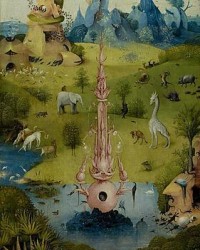
Van de Velde 1982
“Het Aards Paradijs in de beeldende kunsten” (Carl Van de Velde) 1982
[in: (Exhibition Catalogue), Het Aards Paradijs – Dierenvoorstellingen in de Nederlanden van de 16e en 17e eeuw. Zoo, Antwerpen, 25th September-7th November 1982, pp. 17-34, in particular pp. 23-28]
[Not mentioned in Gibson 1983]
Van de Velde focuses on the meaning of the animals in the left interior panel of the Garden of Earthly Delights triptych. Just as the left interior panels of the Haywain and Last Judgment triptychs this panel represents earthly paradise, but whereas the former also depict the Fall of Man, this is not the case in the latter: the main theme of this wing is God’s establishment of holy matrimony. It does not seem likely that all animals (for the most part hybrid monsters) that are populating Eden here have a special meaning. It is remarkable, though, that the animals are fighting and devouring each other.
The question whether the animals of Eden led the same innocent lives as first man, has occupied theologians for a long time. Some authors (i.a. St Basil, St Augustine) believed that these animals had a gentle character, others (i.a. St Thomas Aquinas) thought that the animals had never enjoyed the innocence of paradise. It is difficult to decide to what degree artists and their patrons were aware of these theological disputes. The enmity among the animals in Eden, as painted by Bosch, definitely contrasts the innocence of man. In sixteenth-century representations of the Garden of Eden both tendencies occur.
From the early sixteenth century on, especially in The Netherlands and Germany, Adam and Eve in Paradise was a popular theme in the visual arts. Often, but not always, are they surrounded by a number of animals. Frequently these animals are noted for their fertility or their strong sexual desire and thus they represent unchastity. The presence of these animals refers to the nature of the original sin, which was often interpreted as unchastity, as is also the case in Bosch’s Garden of Earthly Delights. But the animals are not always negative. In the Garden’s left interior panel for instance the elephant and the unicorn are symbols of chastity. The owl refers to wisdom, and so also to Christ.
A round panel painted by Herri met de Bles and representing the Garden of Eden (Amsterdam, Rijksmuseum) also shows a number of animals, apparently with a symbolic purpose. Just as in Bosch’s panel there is already menacing and enmity among them. Similar to Bosch is also that Eden is situated in the middle of a large landscape that changes (on the frame) into a cosmic image with clouds and stars. The function of this panel is unknown.
[explicit]